Recent Water Damage Posts
FAQs About Basement Floods
11/14/2024 (Permalink)
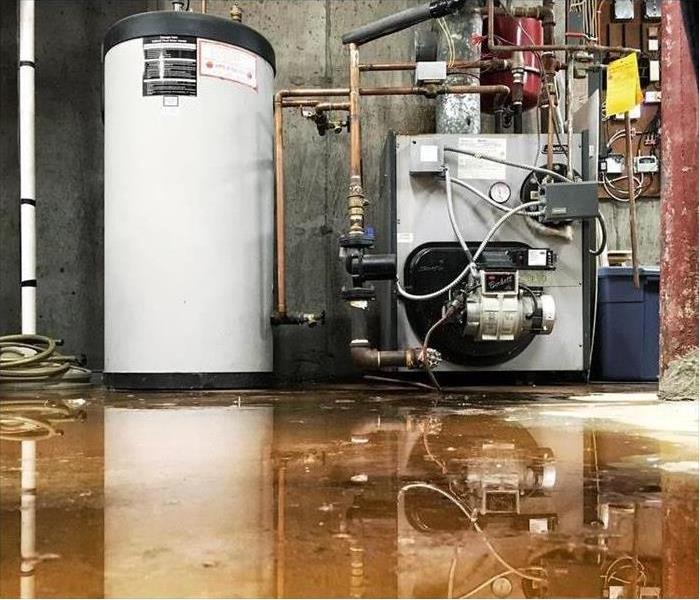 Broken water heater causes flood on basement in Perry, OK
Broken water heater causes flood on basement in Perry, OK
Learn About Flooded Basements
Basements are often great additions to homes, regardless of whether you use your basement in your home in Perry, OK, for storage or for spending time with family. Unfortunately, flooding is a common issue that frequently affects basements. If you have a basement in your home, it can be useful to learn about flooded basements.
What Causes a Basement Flood?
There are various reasons a basement may become flooded. However, some of the most common causes of flooded basements include:
- Natural disasters that cause heavy rains
- A broken water heater
- Damaged supply lines
- Pipe bursts
How Is Water Removed From a Flooded Basement?
Sump pumps and water vacuums are often useful to mitigate small to moderate amounts of water. However, if flooding has caused large amounts of water to enter your basement, you may want to consider contacting water damage restoration professionals. Experts have access to powerful tools and equipment that can remove large amounts of water, and professionals also know how to remain safe when removing contaminated water.
Can You Prevent a Flood in Your Basement?
Since there are various reasons a basement may flood, there is no guarantee that you can prevent your basement from all floods. However, it is possible that you may be able to prevent floods not caused by natural disasters. Ensuring that all appliances and pipes are working effectively and requesting an inspection if you need an appliance or pipe repair can help to prevent a flood. It's also often useful to look for signs of water damage so as to prevent a small problem from turning into a big disaster.
Your basement is an important part of your home, and an area that is particularly prone to water damage from a flood. It's often helpful to know the causes of flooding in basements, how water is removed from a flooded basement and how to prevent a basement flood.
3 Important Questions to Ask About Commercial Content Cleaning
7/26/2024 (Permalink)
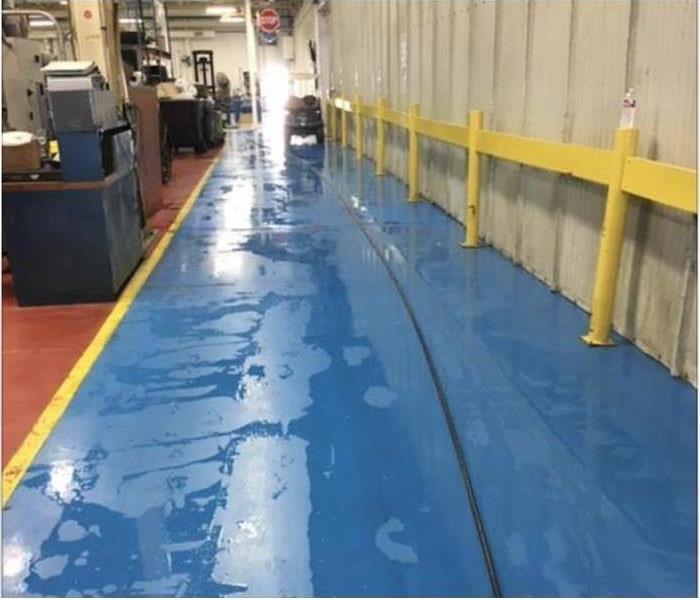 Water damage in a commercial building in Ceres, OK
Water damage in a commercial building in Ceres, OK
3 Questions To Understand About Commercial Content Cleaning
The last thing a business owner wants to deal with is a flooded company. This situation, after all, is both physically and emotionally messy. The establishment in Ceres, OK, must not only be closed, but it must also receive a thorough cleanup, preventing any complications with staff or clients. As proprietors sift through their valuables, they'll need to consider if they can keep something or toss it.
1. How Do You Know What Can Be Saved?
Work with a water restoration company to inspect and review your assets. The experts can look over everything, providing suggestions for what should be done. They'll consider the following points:
- What type of water contacted the piece?
- Is the item porous or nonporous?
- How easily could the owner replace the belonging?
The answers here are vital. As they survey the contamination, the team can provide a plan for you, offering dry cleaning to immersion services. In fact, with their high tech equipment, they can sanitize even electronics and documentation. Don't think all of your hard work has to go to the curb. Discuss the various options available.
2. What Precautions Should Be Used?
A flooded company is a hazard, particularly if the overflow came from a sewer line or external source, such as a lake or ocean. The microbes are seeking residence, growing within the walls and floors. For this reason, extreme caution should be taken to wash anything from the impacted zones. Appropriate personal protective equipment such as masks, gloves and eye wear should be used, preventing germs from spreading.
3. Is Clean Water An Issue?
Even a broken pipe that sprays freshwater is complicated. While it may not contain the microorganisms, too much of it could lead to mold. The major factor would be who easily the scrubbing process could be done. A nonporous substance took in very little, leaving it a simple procedure. Porous pieces, however, are far more complicated. They may not make it.
A flooded company doesn't mean a complete loss. Speak with professionals for guidance.
Commercial Water - Choosing a Water Damage Restoration Specialist
11/3/2023 (Permalink)
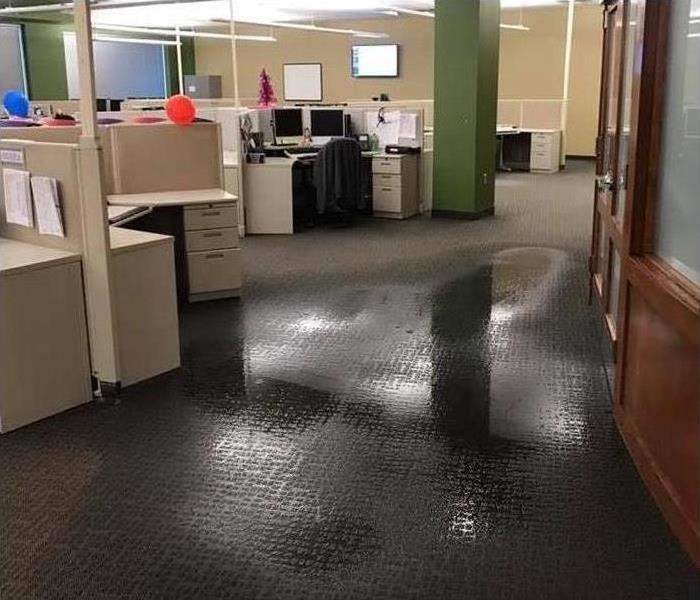 Commercial water damage in Guthrie, OK
Commercial water damage in Guthrie, OK
If your Guthrie, Oklahoma business suffers water damage, there are a variety of other problems that may follow, including mold growth. Understanding the water clean up process can help ensure your commercial building is properly cared for every step of the way.
Choosing a Specialist
Because water damage can quickly lead to mold growth, it is important to begin drying the property as soon as possible. If you choose to hire a professional to help with this task, the following are some important qualities to look for:
- Certification
- Professionalism
- Quick response time
Many professionals adhere to the standards set forth by the Institute of Inspection, Cleaning and Restoration Certification. The IICRC has been developing high-quality best practices for the restoration industry for over 45 years. If a professional is IICRC-certified, he or she has the knowledge to complete the water clean up job properly and safely. For water damage to commercial buildings, a professional who has completed the IICRC’s Commercial Drying Specialist courses will have knowledge of the intricacies involved in commercial water damage that other professionals may lack. However, all the knowledge in the world won’t save your property if the restoration team does not respond quickly enough to prevent further damage. A key sign of integrity and professionalism is a company responding in the time frame they give you and keeping you apprised of any changes.
Cleanup Process
Whether the damage results from a broken pipe, a leaky roof or any other source, the restoration process follows the same basic outline. Standing water is removed using pumps or vacuums. Remaining moisture is dried using fans and dehumidifiers. Affected items are sanitized, and damaged items are repaired. Items that cannot be cleaned, dried and properly repaired are replaced.
Depending on the severity of the damage, business owners may be able to perform the water clean up process themselves. However, an IICRC-certified restoration service can provide valuable assistance, especially in more severe cases.
You Can Replace Your Own Toilet With These 5 Simple Steps
7/26/2023 (Permalink)
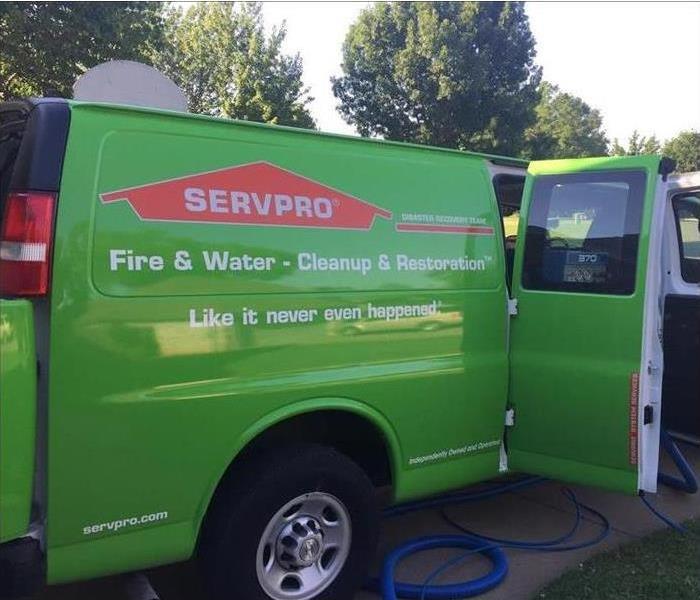 Call in a Guthrie, OK water damage restoration team to ensure there is no extensive water damage
Call in a Guthrie, OK water damage restoration team to ensure there is no extensive water damage
Replace Your Toilet with 5 Simple Steps
Whether you're dealing with a leaking toilet or you simply found a toilet with crazy features at your local hardware store that you just could not live without, you may wonder how much it will cost you to have a Guthrie, OK, plumber come in to make the swap for you. Depending on your capabilities, resourcefulness and level of confidence this may be an unnecessary concern. You can replace your toilet five simple steps.
1. Sever the Water Supply
Whether you're making a toilet repair or swapping out an old toilet with a new, you need to be sure to cut the water supply. Once the supply line is disconnected, flush and drain the tank.
2. Detach the Wax Seal
Use a wrench to loosen the bolts holding the toilet, then take a pocket knife or other sharp object and cut the caulk seal surrounding the base of the toilet. Remove the toilet gently. Use a putty knife to remove the wax seal.
3. Caulk the New Base
This step can help you prevent a future leaking toilet, as caulk serves to eliminate gaps between the wax ring and toilet base. It also helps make installation easier.
4. Install a New Wax Ring
You do not want to reuse a wax ring. Place a new one where the old was, and then lift the new toilet into place. Do not press down, as the weight of the fixture will compress the seal itself.
5. Tighten the Bolts
Once the toilet is in place, place a washer over the bolts and tighten the nuts by hand. You can use a large screwdriver or wrench to finish the job. Be careful to not overtighten, as it will crack the ceramic.
If your leaking toilet was leaking for a while, you may want to call in a Guthrie, OK, water damage restoration team to ensure the there is no extensive water damage. Failure to properly clean water damage can result in costly issues in the future.
When is Carpet Replacement Required?
11/5/2022 (Permalink)
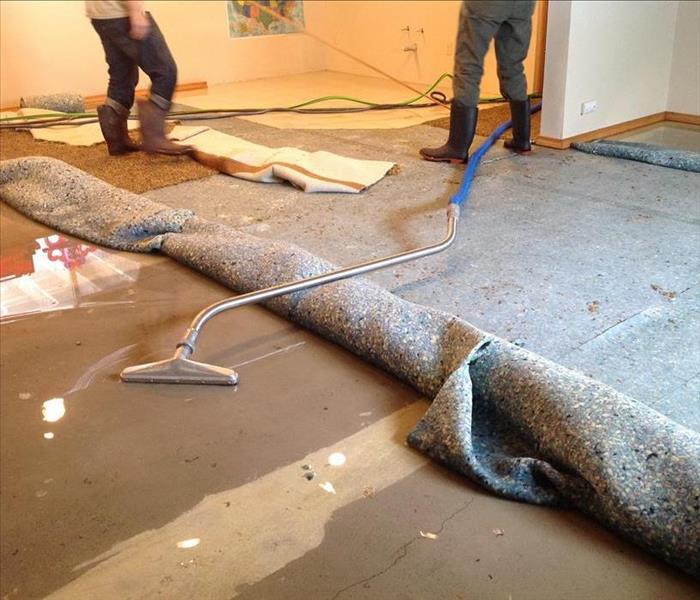 Carpet replacement in a Stillwater, OK home
Carpet replacement in a Stillwater, OK home
When Do I Need to Replace My Carpet?
Carpet replacement is more than just a cosmetic change. It can be the difference between having a clean home and one filled with bacteria. When should you replace your carpet? The answer depends on how often it gets used, how much foot traffic it gets, and how frequently it's cleaned. Here are some other factors to consider:
Water Damage and Carpet Replacement
If you have a leaky pipe or another clean water source, the carpet can be saved. The key is to dry the area as quickly as possible. If water sits long enough, it will begin to break down and ruin the fibers of your carpet.
If your carpet has been exposed to any type of dirty or soiled water (think: mud or blood), then replacement is necessary because these types of contaminants cannot be cleaned out effectively. In addition to being stained, they also introduce bacteria that could potentially cause mold growth in your home over time.
If the water source is clean, such as a pipe burst or supply line, you may be able to save your carpet. However, if it’s been wet for more than 24 hours, your carpet may be unsalvageable.
Carpet Damage from Mold
As you know, mold is a fungus that grows in damp and dark places. This can be anywhere from your basement to inside your carpeting. When water spills onto the carpet, it will have nowhere else to go but into the padding underneath the carpet. The padding then becomes wet and gives way to mold growth.
The worst part about mold on your flooring is that it can take up to two weeks for the smell of mildew to dissipate once dry. This means that you'll need professional help if you want everything back to normal by then!
It's important to know how much water damage is acceptable and how much water damage is too much. The following sections provide information on determining whether or not your carpets are salvageable, as well as tips for determining when it's time to start shopping for new carpeting.
In general, there are three main indicators that your carpet has experienced enough damage for replacement:
- The amount of visible mold growth or mildew on the flooring;
- How long it takes for moisture from the damaged area to evaporate; and
- If there are any signs that an odor remains in the room after it has been cleaned up (i.e., a lingering smell like mildew).
When should you replace your carpet? The answer to this question depends on a few factors. Age, type of water damage and amount of damage will all play into whether or not it becomes necessary for you to replace your carpets. If you have any questions about replacing your carpeting in your Stillwater, OK home or business, or if you would like more information about the process please feel free to call us at (405) 332-2122.
Understanding Flood Water Types
7/30/2022 (Permalink)
 Identify your water type and talk to a water damage specialist to schedule proper removal.
Identify your water type and talk to a water damage specialist to schedule proper removal.
Knowledge of Flood Water Types
Water can be a priceless resource for drinking and cleaning. But dirty water can be a major danger to your home. Be it from a flood, a backed-up supply line or even an overflowing toilet, contaminated water poses a major threat if it isn’t properly cleaned up. What are the three main types of water to look out for in your Stillwater, OK home? Read on for the answers.
Different Water Sources
Of course, all H2O is chemically the same. Differences come down to where it comes from and more specifically, what materials it may have encountered. The main three categories of flood water are:
- Clean water
- Gray water
- Black water
The latter two are forms of contaminated water that can be a major threat to your health.
Clean Water
When it comes to flooding, clean water is the least offensive type. This water typically comes from roof leaks, appliance malfunctions, tub overflows, or any other source that does not naturally involve human or animal waste. The main threat from this type of water is mold and mildew damage.
Gray Water
As its name suggests, this type of water falls in between good and bad. This is mildly soiled water due to its origin. It may be tainted by microorganisms, and typically comes from sump pump failures, toilets, or dishwashers. Gray water should be removed quickly to avoid progressing to the next level.
Black Water
By far the worst type of flood water to encounter, black water carries significant health hazards. Stemming largely from toilets, this water is pathogen-rich and often contains urine or feces. This water can carry hepatitis, cryptosporidiosis, gastroenteritis and more so it’s important it’s professionally removed, fast.
Understanding if contaminated water is causing your home damage is an important step in making a cleanup plan. Identify your water type and talk to a water damage specialist to schedule proper removal.
4 Ways To Prevent Home Water Damage
5/18/2022 (Permalink)
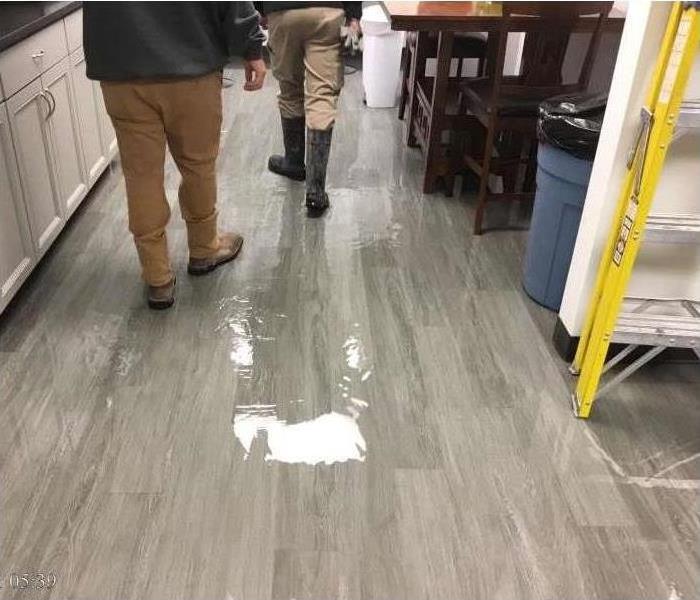 A kitchen leak causes damage to a home in Navina, OK.
A kitchen leak causes damage to a home in Navina, OK.
Protect Your Home From Unexpected Water Damage
Imagine returning from vacation only to find your home flooded and in need of a water pipe repair and cleanup from a water damage restoration company. Those who leave their house unattended for days at a time can be susceptible to water issues though in many cases, this is preventable. Follow these four tips to protect your Navina, OK, home from unexpected water damage.
1. Check for a Possible Broken Pipe or Leak
Inspect areas of your home for potential leaks, including your roof, water heater and pipes underneath all sinks. Detecting any broken pipes or troublesome leaks before leaving on a trip and addressing them right away can save you many headaches of coming home to surprise water damage.
2. Enlist Someone to Watch the House
If you plan to be away on vacation, it's wise to arrange for someone to stop by your home periodically and check on things. Make them familiar with your home's water main shut-off valve so the water supply can quickly be stopped in case an emergency water pipe repair is needed. If no one is available to do so, shut off the water main before leaving your house.
3. Clear Out Gutters
A simple way to prevent water damage is to clean your gutters. If clogged, water may not flow freely out of the downspout and can instead seep into your home. Be sure to check the state of your gutters before spending any significant time away from your house.
4. Be Mindful of Insulation
Never leave your house empty for a long period without considering its insulation first. Exposed pipes need proper insulation in freezing weather to prevent them from bursting. The best way to prevent this type of water pipe repair is to leave the heat on in your home during cold stretches.
Before your next trip, follow these simple steps so you can leave with the peace of mind that your home is best protected from water damage.
Putting a Stop to a Toilet That Won’t Stop Flushing
3/17/2022 (Permalink)
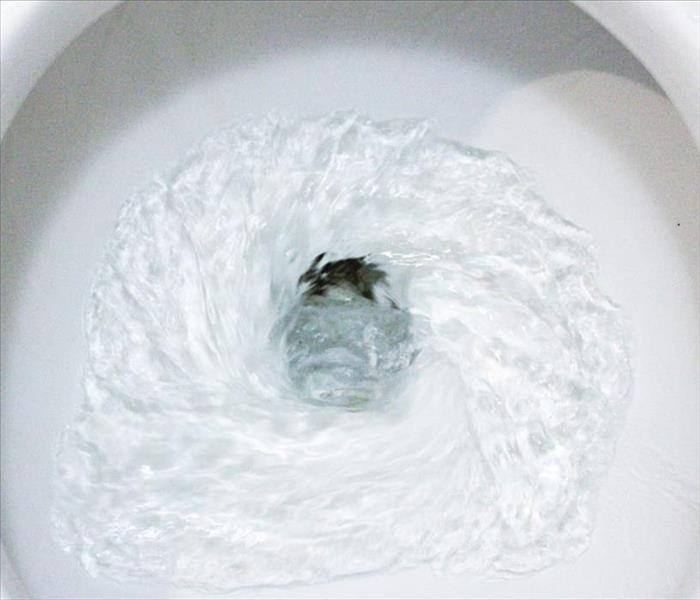 A toilet that won't stop flushing can lead to water damage in your building.
A toilet that won't stop flushing can lead to water damage in your building.
Prevent a Toilet Flood In Your Commercial Property
A toilet that won’t stop flushing may not seem like a big deal, but toilet overflow can pose serious problems not just for the bathroom but other parts of your commercial property as well. As a toilet flushes, more water enters the toilet and can possibly spill over, seeping into the floor or the wall. This can lead to water damage and mold growth in your building in Navina, OK. Water on the floor is not only a potential slipping hazard, but it may also contain odors that impact the usability of your bathroom. It’s important to stop a toilet from continuous flushing that can lead to flooding.
Fixing the Flushometer
The flushometer Is a component that controls the flushing on a commercial toilet. Here’s how you can prevent a toilet flood by fixing the flushometer:
- Use a flathead screwdriver to turn off the flushometer on a manual system. This is usually to the left or the right of the toilet’s pipe connection to the wall.
- Remove flange cover.
- Remove gasket and clean thoroughly, including the weephole. You may need to use a small, thin object to really clean the weephole.
- Replace gasket and flange cover and turn on flushometer.
- An automatic flushometer may require servicing.
Consult a professional water damage restoration specialist to make repairs and remediation for items impacted by toilet overflow. These pros are fully equipped and experienced in making any repairs necessary to bring your space back to pre-damage conditions. If any specialized techniques or approaches are needed such as odor control and disinfection, they will know best how to apply them.
Trusting the Professionals
While addressing a flushing toilet is something you may be able to do yourself, you should leave cleanup to a professional remediation service. Your custodial staff cannot fully repair and remediate any spaces or objects impacted by the water damage of toilet overflow. If your business or that of your tenants’ is interrupted by the damage, the professionals can minimize the repair period.
Don’t ignore a toilet that continues to flush. It can lead to serious damage, requiring commercial building restoration.
4 Tips To Prevent Frozen Pipes
2/9/2022 (Permalink)
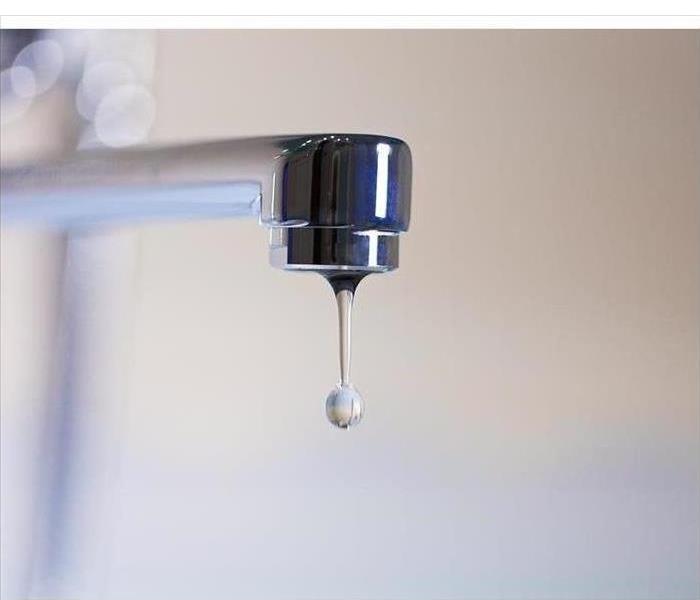 Let water drip from the faucets.
Let water drip from the faucets.
Prevent Frozen Pipes
Cold weather can cause your pipes to freeze and even burst. Frozen water puts incredible pressure on pipes and can cause them to crack, resulting in water damage when the ice thaws and water begins to seep through the cracks. Pipes located in areas of your home with little insulation, such as outdoor and attic pipes, typically have a greater risk for freezing, but it is important to monitor all pipes in your Stillwater, OK home for cracks during cold weather. Waterline repair can be expensive, so when facing particularly cold temperatures, it is usually a good idea to use these four tips to keep from having frozen pipes.
1. Keep the thermostat the same temperature both day and night. Lowering the temperature in your home at night may help lower your electricity bill, but the change in temperature may put added pressure on your pipes. By not changing the thermostat, the water flowing through pipes is kept warmer, and you can probably avoid a frozen pipe disaster.
2. Let water drip from the faucets. Your pipes are usually at the greatest risk of freezing during sudden cold snaps. Flowing water is less likely to freeze, so letting water drip continuously from kitchen and bathroom faucets can prevent frozen pipes. Periodically running the faucets at full blast may also be a good idea.
3. Open cabinet doors. Exposing pipes to warm air helps keep them from getting too cold. Because most exposed pipes are located under kitchen and bathroom cabinets, opening the doors can help warm air circulate around the pipes.
4. If you are traveling, set the thermostat above 55°F. When you will be away from home, you probably don’t want to waste electricity warming your property. Resist the urge to set your thermostat lower than 55° F, because your water pipes still need to stay warm.
Dealing with frozen pipes in Stillwater, OK can be a nightmare. Using the above four tips during freezing weather can usually help you avoid expensive water line repair.
Your Noisy Water Heater Is Trying To Tell You Something Important
12/29/2021 (Permalink)
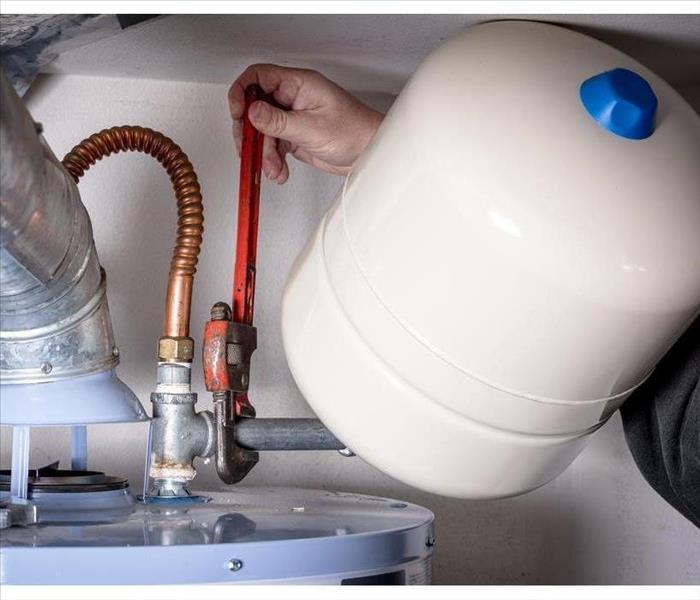 Maintenance in your water heater can prevent a flood.
Maintenance in your water heater can prevent a flood.
Diagnosing Water Heater Problems
Think back to when your heater was still new. It may not have been completely silent, but because it was new, you were certain that the sounds you heard were normal. Then, one day, your heater began to make new sounds. It started to complain. Its first word may have been pop or click or buzz, but it was trying to tell you something was wrong.
Diagnosing heater problems by sound is an art. A professional plumber knows what your heater is complaining about. What follows are some common sources of and solutions to heater problems.
1. Gas and oil burners require special consideration. Safety is always a concern. Where there is a flame, there is a risk of fire or carbon monoxide poisoning. Burner problems are not common but are important to understand and consider. If your burner shows any indication of a problem, call a trained professional immediately.
2. Sediment is a common source of heater noise. Most sediment is sand or any solid material that finds its way from your well or water main into your water heater. Even in Ceres, OK, there is no way to avoid it. The noise comes from the water moving around the heating element and dislodging the sediment. Performing a water heater flush should eliminate this problem.
3. Mineral deposits can interfere with the operation of safety devices. Hard-water mineral deposits can foul pressure relief valves and backflow preventers. Noise from those devices may indicate a mineral buildup and suggest that the tank needs to be de-limed.
Simple Water Heater Maintenance Can Prevent a Flood
Inspecting, flushing and de-liming a water tank will help eliminate many causes of failure. Still, tanks can fail. When that happens, local water damage specialists can quickly deal with the flood and return your home to its former condition. It starts with a phone call.
Making a Water Damage Claim: Five Steps
11/23/2021 (Permalink)
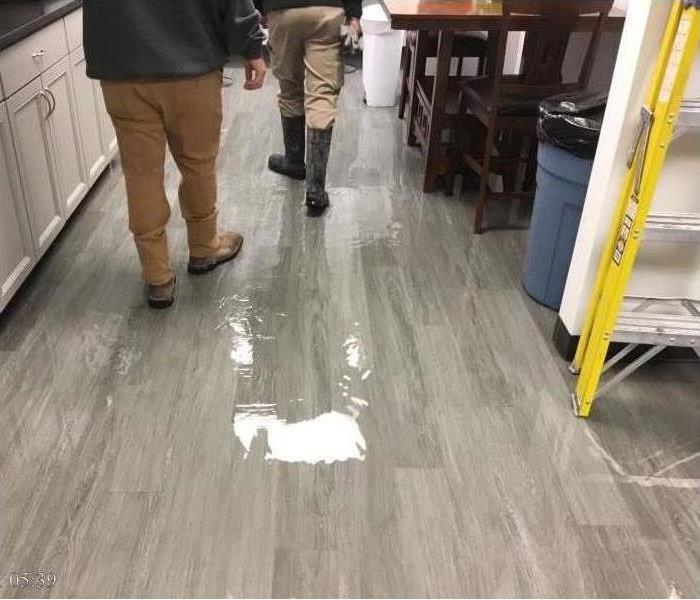 Water damage in a kitchen in Guthrie, OK.
Water damage in a kitchen in Guthrie, OK.
Five Steps to Filing a Water Damage Claim
If a burst pipe has led to flooding and related damage to your home, you are probably interested in the process involved when making an insurance claim. Read on to learn about 5 important steps you need to take to submit the claim and prepare for an insurance adjuster to arrive.
1. Check Your Insurance Policy
One of the first things that you will want to do after a pipe burst in your Guthrie, OK, home is to review your homeowners insurance policy. Water damage is covered by some policies and not others.
2. Call the Insurance Company
If you have learned that you do indeed have flood coverage, the next step is to call your agent to make an insurance claim with the company that handles your policy. If all goes well with your report, an appointment will be set to have the damage surveyed.
3. Take Pictures and Record Damage
Once you learn that an adjuster is coming to evaluate the situation, you will need to get working. Take pictures and record any issues that you find, as these will be valuable resources for the claims team to take into account.
4. Fill out Forms
You may have to fill out claim paperwork before the adjuster arrives. Be as thorough as you need to be, and make sure to meet the stated deadline.
5. Make Repairs
It is usually a good idea to make at least some repairs when you can to preserve your property to the best of your ability before the adjuster arrives at your home. Contacting water damage specialists is often your best bet to get the work completed quickly and accurately.
Filing an insurance claim can be difficult after water ruins your valuables and property. The emotional effects of having your home in danger are challenging enough without going through complicated insurance processes. Remembering the steps above will help you to better understand what is involved and how to accurately file a claim so you can figure out a way to move forward.
The Importance of a Regular Sprinkler Maintenance Schedule
9/27/2021 (Permalink)
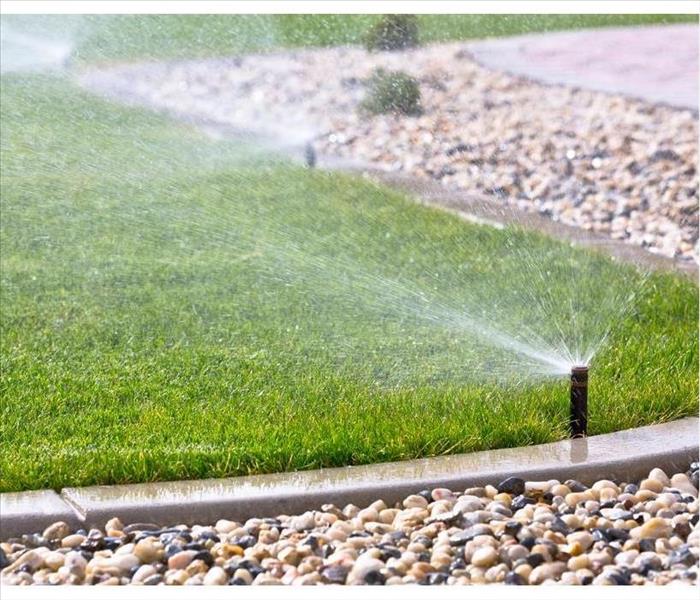 Having an irrigation maintenance schedule is a smart choice.
Having an irrigation maintenance schedule is a smart choice.
The Importance of a Scheduled Sprinkler Maintenance
Your sprinkler system is designed for your convenience. You likely had it installed so that you wouldn't have to worry about whether or not the landscaping on your commercial property in Guthrie, OK, gets watered frequently enough. You set the schedule, and the sprinklers do their job. Proper irrigation maintenance, however, is essential to ensuring this happens. Without regularly scheduled maintenance, your sprinklers could malfunction and flood your building.
Monthly
You should check sprinkler heads, valves, nozzles and pipes on a regular basis. You may think your sprinklers are just sitting out on the lawn, waiting to be enacted, but there are many things going on that could damage a sprinkler:
- Environmental hazards, such as high winds, blowing debris in to damage or clog the system
- People kicking the sprinkler heads as they trudge across the lawn
- Dogs or other animals chewing or digging around the sprinkler
- Cars jumping the curb and running over a sprinkler
Because so many things can happen when you're not looking, your irrigation maintenance schedule should include an inspection of the working parts of your system at least once a month.
Seasonally
In most places, the weather can change drastically with the season. This includes precipitation levels, which directly affect your need for irrigation. Adjust your watering schedule to the season to avoid sprinkler flooding that may necessitate water mitigation services.
Yearly
Auditing your system once a year to ensure that everything is not just functioning but working efficiently helps you keep track of when system parts may need updates. Check for broken sprinkler heads and leaks. You can save money not only on the costly repairs that result from a long-term problem but also on your water bill.
Having an irrigation maintenance schedule is a smart choice. It takes a little time and organization, but it pays off in the amount of money you save by avoiding large repairs.
Inspection and Maintenance of Bathroom Supply Lines
6/29/2021 (Permalink)
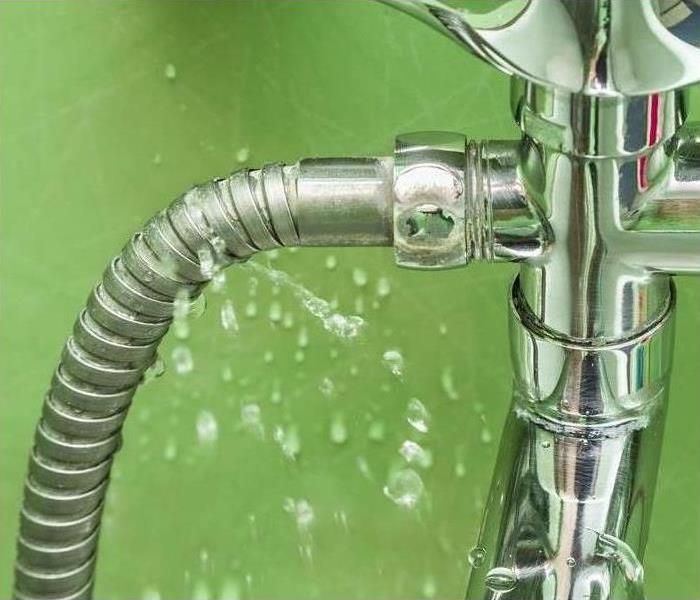 Supply line damage takes time and money to repair.
Supply line damage takes time and money to repair.
Supply line damage can lead to many disasters. If leaking, the pressurized tube can release a lot of water, which can ultimately lead to serious water damage. To avoid the time and expense of restoration and repair, here are a few tips concerning supply lines.
What Is a Supply Line?
A supply line is a tube that connects to a faucet, toilet, dishwasher, sink, and other fixtures. It transfers water from the pipe into the fixture. These lines are normally made from plastic or stainless steel tubing. This tubing is flexible and is often braided to increase the strength and durability of the line.
How Does It Get Damaged?
Supply line damage isn’t rare. A few ways that they can get damaged include the following:
- High amounts of pressure. This pressure can escape through weak joints
- Sediment build-up. This can block the water and cause the tube to bulge and burst.
- Corrosion can cause leaks that can easily expand.
Unlike a subtle bathroom leak that happens under the floor or within a wall, a supply line leak is easy to spot. If you find one in your bathroom, quickly shut off the water supply. This will prevent any more water from escaping the line and entering parts of your home that normally don’t get water.
When Should I Inspect my Supply Lines?
All pipes and plumbing should be inspected yearly in Perry, OK, to ensure the integrity of your home’s water pipe system. However, supply lines should be checked often. Check for drips, bulges, and any corrosion that you might notice. It’s also important to test the shut-off valves to see if they are working properly.
Supply line damage takes time and money to repair. Daily use of sinks, toilets and other fixtures makes it even easier for leaks and bursts to occur. However, by taking care of your supply lines and inspecting them yearly, you can stop water damage from happening.
3 Reasons You Might Find Water in Your Crawl Space
3/9/2021 (Permalink)
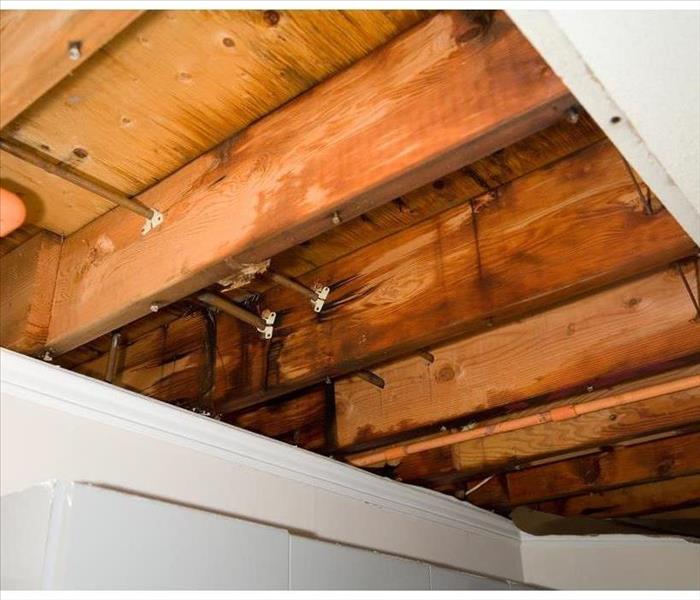 Wet crawl space in Ceres, OK.
Wet crawl space in Ceres, OK.
Common Causes For Water Inside A Crawl Space
A wet crawl space can create more problems than you might expect. It makes water damage less visible, but it also creates the perfect conditions for mold growth. The moisture also weakens the Ceres, OK, house's structural materials, creating greater damage as a result. Learn about the most common causes for water inside the crawl space so you can prevent an incident.
1. Overwatered Plants
You can accidentally flood the crawl space by doing something as simple as overwatering plants, especially those close to the house's foundation. Whether you use too much water or leave the hose or sprinkler running beyond the necessary time, the excess will seep into the house and reach the lower sections first. You can easily turn off the water to resolve this issue. You can spot this problem if you see water pooling near the affected area.
2. Poor Sloping Grade
Another factor that can result in a wet crawl space is the lack of proper grading around your house. Ideally, you want the grading to slope away from the building and towards the outer yard or the streets. This feature ensures that any incoming water flows away from the foundation, preventing flooding. Check the grade after winter, intense rainfall or an overwatering incident. If the slope is altered or missing, build it up between six to eight inches away from home.
3. Defective Plumbing
Another reason why you might find water inside your crawl space involves defective or broken pipes. Even if the leak or burst pipe is in the house's upper floors, the water will always trickle down. If you find water in the crawl space or lower area, conduct a detailed search to find the source and fix it. Hire a plumber if you are unable to find it.
You should deal with a wet crawl space fast before mold growth and water damage threatens your home. Identify these occurrences to avoid this situation and contact emergency remediation services if you find water in that area or anywhere else.
The Top 3 Causes of Major Water Damage
2/10/2021 (Permalink)
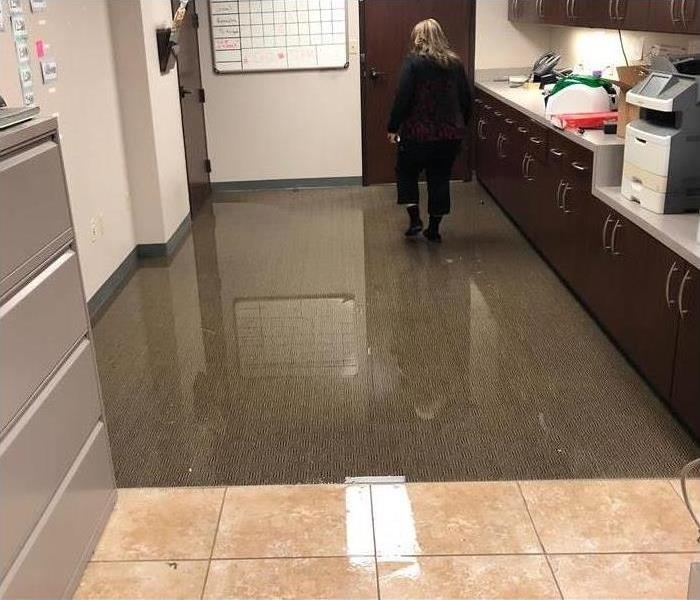 Commercial water damage in Stillwater, OK.
Commercial water damage in Stillwater, OK.
Water Damage At Commercial Building
Water damage can occur at a commercial building due to problems with the pipes and sewer lines or outdoor flooding. A supply line break calls for pipe burst cleanup, a sewer backup may require cleaning out the line and backups or floods both require disinfection of materials exposed to contaminated water. Learn more about three common causes of water damage at commercial buildings in Stillwater, OK.
1. A Broken Pipe
When a pipe breaks, hundreds of gallons of water may flow into the interior of a building. The amount of time between the start of a leak, detection and repair determine the severity of water damage. Regardless of the amount of water, clean water from a supply line is Category One water damage. Pipe burst cleanup is the most common cause of large-scale water damage.
2. A Sewer Backup
A blocked sewer line or an overflowing main may cause a backup into the lowest level of a building. Sewer water contains solid waste and is considered Category Three water damage. Cleaning and disinfection are necessary, and a building owner may want to contact a sewer cleanup company to avoid mold or other secondary damage.
3. A Flood Incident
Flooding due to heavy rain that does not drain properly or overflowing bodies of surface water is the third most common cause of major water damage. Flood water is also Category Three damage, as water becomes increasingly contaminated as it travels over surfaces toward a building and remains standing until extraction can take place.
Pipe breaks and sewer backups are the most common causes of large-scale commercial water damage in Stillwater, OK. Flooding may be less likely, but can also cause major damage to the interior and exterior of a structure. Respond to the cause of damage by arranging for pipe burst cleanup or other mitigation measures followed by a complete restoration.
Why Water-Flooded Lights Are Dangerous and How They Should Be Handled
12/29/2020 (Permalink)
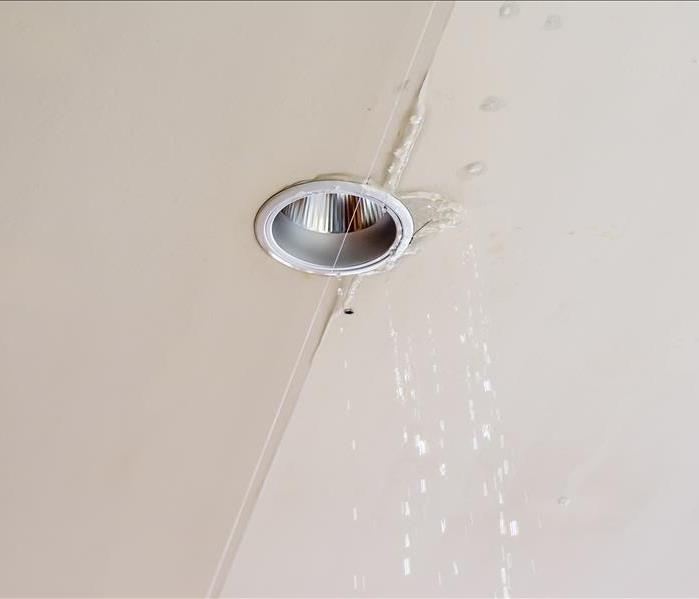 If ever water in light scenario emerges inside your residence, treat the event with caution
If ever water in light scenario emerges inside your residence, treat the event with caution
When your home in Ceres, OK, experiences water in light fixtures, danger is always present. Mitigating the peril is imperative. Here are a few reasons why rooms containing water-flooded lights should be avoided and what you must do once they occur.
Flooded Lighting Dangers
Never stand or walk underneath damp fixtures, as:
- Electrified drips could deliver a severe shock
- The wiring could become compromised and a fire may start
- Ceiling damage could cause a collapse
The wisest choice you can make is to hire a residential water restoration expert to set things right on your behalf. The possibility of electrocution and other related hazards make attempting to reverse any water in light situation on your own extremely foolish.
Flooded Lighting Protection Measures
Always take action to minimize the peril posed when water mixes with electricity. The first priority should be shutting off power. Once this has been done, test out dry appliances with a non-contact voltage tester to verify that all wattage has been definitively cut. Assuming the moisture’s origin is a leaky pipe, shut down your water supply with equal urgency. Only allow a professional plumber to fix your lines, just as a qualified electrician must be hired to correct compromised lights.
Buckets and towels underneath dripping apertures can help prevent floors from sustaining further damage. Stop wood from continually soaking up water by drying everything as quickly as possible. Open windows and doors to accelerate the aeration process. Strategically placed fans can also move evaporation forward.
Light switches should be covered with duct tape, so no one accidentally transforms an otherwise non-threatening puddle into a hazard. Prevent entry into jeopardized spaces by shutting doors and hanging warning signs on them.
If ever a water in light scenario emerges inside your residence, treat the event with caution. Respect the area as you would any hazardous locale and immediately contact reliable professionals to alleviate the risk.
Three Causes for Bursting Pipes
12/1/2020 (Permalink)
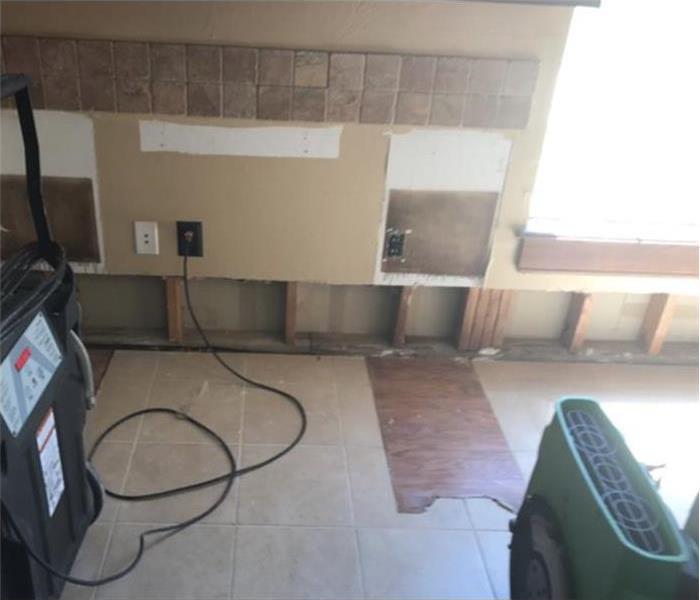 Water damage in Perry, OK
Water damage in Perry, OK
What Causes Pipes To Burst
Bursting pipes can be a disaster for homeowners, having effects not limited to:
- A flooded home
- Severe water damage
- Moisture retention and mold
- Damaged furniture, carpet, walls, and ceilings
It is important to call a plumber right away to fix broken pipes and prevent water damages. Knowing what causes pipes to burst could help you prevent them. Here are some possible causes for a burst pipe in Perry, OK:
High Water Pressure
If the water pressure in your home is too high, your pipes will be susceptible to corrosion-caused leaks. Pipes are only made to handle around 60 psi. When the water running through your pipes exceeds this pressure, your pipes can burst. The best way to diagnose high water pressure in your home is to use a pressure gauge on the faucet nearest to the main water supply line.
Improper Soldering
If the pipes in your home are not soldered properly, the water running through them could seep through the crevices in the pipe connections. The water escaping from the unsoldered joints often go unnoticed until a water stain develops on to walls or ceilings. Improperly soldered pipes should be addressed immediately to prevent bursting pipes from flooding your home.
Moving Pipes
If you hear clanging from water moving around your pipes, you have a water hammer problem in your home's plumbing system. When the shock-absorbing mechanisms around your pipe become waterlogged, a water hammer can develop. The movement of the pipes causes the joints to become worn over time. Worn joints will eventually burst if they are not addressed in time.
The damage from bursting pipes can be catastrophic for homeowners, especially if a home becomes flooded. Leaks and burst pipes can be avoided with proper plumbing maintenance. Frequently check your pipes for high water pressure, bad soldering, and water hammer. If a pipe has burst in your home, a water damage restoration service will aid in cleaning and restoring your property.
Steps To Take When a Broken Pipe Floods Your Home
10/7/2020 (Permalink)
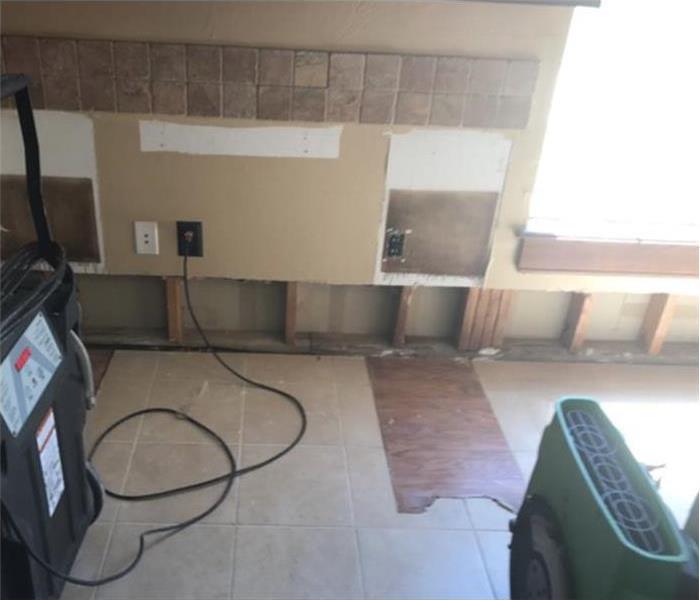 Residential water damage in Navina, OK
Residential water damage in Navina, OK
Take The Following Steps To Restore Your Home After Water Damage
A broken pipe can cause your home to flood in a matter of minutes. Flooding can cause severe damage to your home's interior and belongings, including
- Carpets and Drapes
- Electronics and Appliances
- Floors and Ceilings
- Furniture and Upholstery
- Clothing and Papers
Taking the following steps can mitigate the damage and restore your home's livable condition.
Shut off the Electricity
When excessive water in home causes flooding, it is wise to shut off the electrical supply for optimum safety. Fast-moving water can quickly seep into power outlets and immerse wiring, leading to hazardous conditions and possible electrical fires.
Remove and Dry
It is essential to begin drying your home's interior and belongings before mold can develop. Start by placing objects like carpets and pillows outside to dry. Portable dehumidifiers are helpful, but a professional restoration service may need to perform intensive water vacuuming that tackles extreme water in home to prevent mold or keep it from spreading.
Clean and Sanitize
Water from a broken pipe can spread contaminants throughout your home. Cleaning and sanitizing are necessary to remove hazardous substances and address mold. Visible damage, including stains on the walls and ceiling, indicates that water has reached your home's interior structure and caused mold to develop. By this point, mold remediation measures are necessary to clean the air, interior spaces, and your belongings.
Repair and Prevent
Once you have addressed the immediate concern of removing water and cleaning and sanitizing your home, it is necessary to focus on the issue that led to the flood. A thorough examination of your home's plumbing system may reveal other vulnerabilities and needed repairs that can prevent future disasters from wreaking havoc on your home.
When a broken pipe causes your home to flood, you can rely on a professional cleaning and mold remediation service in Navina, OK, to mitigate the damage and restore your home to pristine condition.
Commercial Water - Choosing a Water Damage Restoration Specialist
8/21/2020 (Permalink)
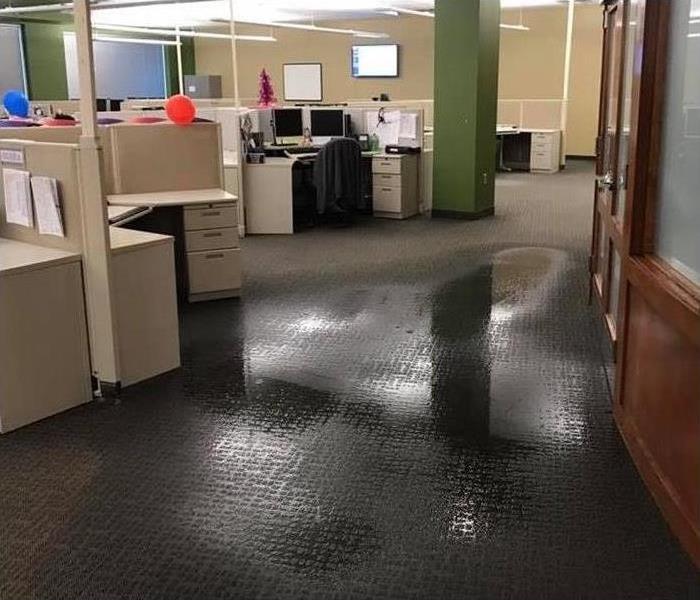 Commercial water damage in Guthrie, OK
Commercial water damage in Guthrie, OK
If your Guthrie, OK, business suffers water damage, there are a variety of other problems that may follow, including mold growth. Understanding the water clean up process can help ensure your commercial building is properly cared for every step of the way.
Choosing a Specialist
Because water damage can quickly lead to mold growth, it is important to begin drying the property as soon as possible. If you choose to hire a professional to help with this task, the following are some important qualities to look for:
- Certification
- Professionalism
- Quick response time
Many professionals adhere to the standards set forth by the Institute of Inspection, Cleaning and Restoration Certification. The IICRC has been developing high-quality best practices for the restoration industry for over 45 years. If a professional is IICRC-certified, he or she has the knowledge to complete the water clean up job properly and safely. For water damage to commercial buildings, a professional who has completed the IICRC’s Commercial Drying Specialist courses will have knowledge of the intricacies involved in commercial water damage restoration that other professionals may lack. However, all the knowledge in the world won’t save your property if the restoration team does not respond quickly enough to prevent further damage. A key sign of integrity and professionalism is a company responding in the time frame they give you and keeping you apprised of any changes.
Cleanup Process
Whether the damage results from a broken pipe, a leaky roof or any other source, the restoration process follows the same basic outline. Standing water is removed using pumps or vacuums. Remaining moisture is dried using fans and dehumidifiers. Affected items are sanitized, and damaged items are repaired. Items that cannot be cleaned, dried and properly repaired are replaced.
Depending on the severity of the damage, business owners may be able to perform the water clean up process themselves. However, an IICRC-certified restoration service can provide valuable assistance, especially in more severe cases.
Steps for Cleaning Your Home After a Sewage Flood
6/4/2020 (Permalink)
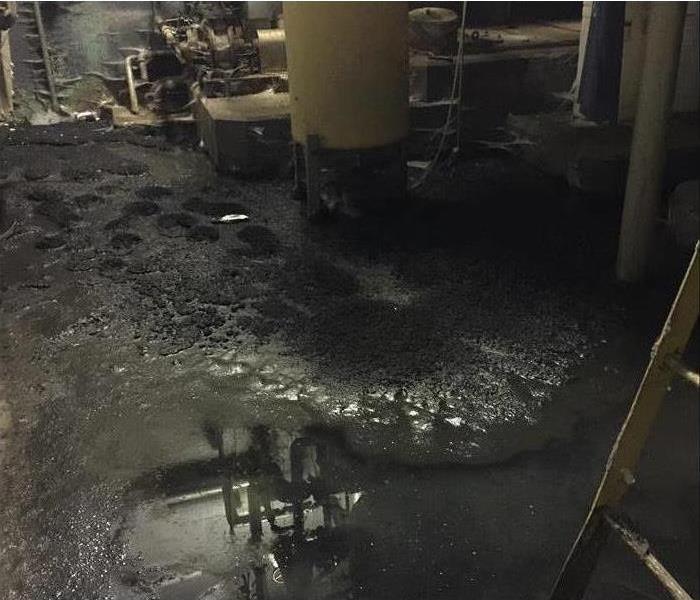 If your home suffers a sewer backup, quick sewage cleanup is crucial
If your home suffers a sewer backup, quick sewage cleanup is crucial
What Steps Should Be Taken?
Discovering a flooded toilet at your Perry, OK, home is bad enough, but when it’s due to a sewer backup, it’s even worse. Sewage cleanup needs to begin immediately. So, what steps should be taken?
1. Practice Safety
First and foremost, evacuate everyone from the affected area. Anyone who’s working to remediate the situation should wear personal protective equipment (PPE). Goggles, a respirator, rubber gloves, Tyvek coveralls, and rubber boots are ideal. The area may also need to be contained to protect unaffected areas. Utilities should be turned off immediately, including electricity, gas, and water. To be safe, the utility company should be contacted for shutoff. Do NOT enter the area beforehand
2. Ventilate the Area
Proper ventilation is essential after a sewer backup. The stench and harsh odors from cleaning chemicals can be overpowering. Circulate air by opening windows and doors and running fans. However, don’t turn on the HVAC system; it can cause cross-contamination into other parts of the house.
3. Extract Standing Water
A wet/dry vacuum is one of the safest, most effective tools for removing standing water and small debris during sewage cleanup. They can be rented or easily found in hardware or department stores. If there’s debris, make sure the hose doesn’t clog. Also, be sure to empty the tank before it gets too full.
4. Dispose of the Unsalvageable
Next, anything that can’t be thoroughly cleaned, disinfected, and dried within 48 hours will have to be disposed of. Many porous materials such as drywall, carpeting, and upholstery will probably be unsalvageable.
5. Clean, Sanitize and Dry
When all unsalvageable materials have been removed, any leftover raw sewage and debris need to be eliminated. Then, all remaining contaminated materials and surfaces require thorough cleaning and sanitizing. Finally, it’s crucial that everything is dried thoroughly within 48 hours to prevent mold growth.
If your home suffers a sewer backup, quick sewage cleanup is crucial. Proper safety measures are important and can be performed by restoration experts.
6 Ways To Prevent Residential Water Damage
5/28/2020 (Permalink)
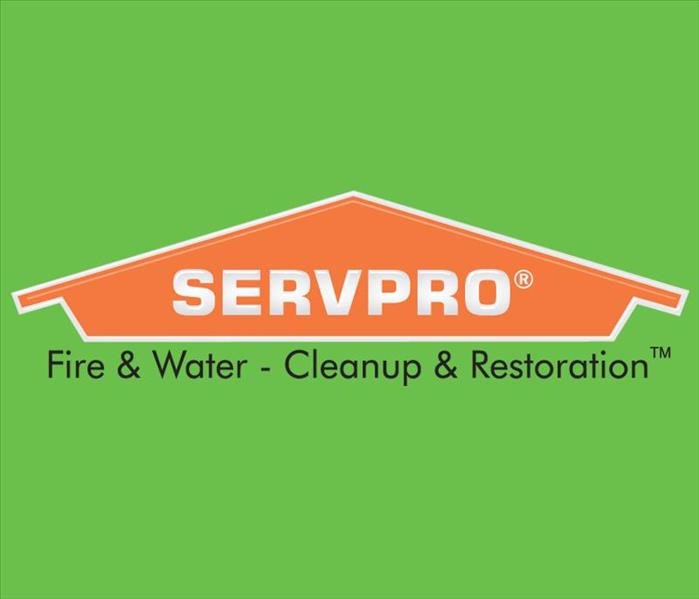 While the above methods are great for keeping water in home plumbing and away from fragile structural components, accidents inevitably happen.
While the above methods are great for keeping water in home plumbing and away from fragile structural components, accidents inevitably happen.
Keeping water in home plumbing and away from the structure and components of a house is crucial to preventing damage. You can contact a water mitigation company in Stillwater, OK, to assess the vulnerabilities of your home, but protecting it from water damage comes down to six things.
Plumbing inspections
Gutters and downspouts
Seals
Sump pumps
Backflow preventer or valve
Landscape grading
Plumbing Inspections
The best remedy to a broken pipe is never to let it break. Annual or bi-annual plumbing inspections — one in the fall and the spring — provide homeowners with some security against expensive plumbing repairs because they always understand the health of their system.
Gutters and Downspouts
Homeowners often neglect their gutters and downspouts, which can cause significant water damage to your roof and foundation. Performing routine gutter and pipe cleanup ensures that excess water is pushed away from your home.
Seals
Window and door seals prevent water in home breezeways and rooms, but the material does not last forever. Check your window and door seals every spring and fall for cracking or other signs of wear and replace where needed.
Sump Pumps
Basements are vulnerable to flooding, and sump pumps help protect against such possibilities. If you have a sump pump, check its functionality throughout the year. If you don't have a pump in your basement, consider the investment.
Backflow Preventer or Valve
Backflow preventers keep freshwater sources fresh and prevent sewage backups. Plumbers install the valve within a home's plumbing, and it only allows water to travel one way, keeping external or wastewater sources out of your home.
Landscape Grading
Your landscaping should always angle away from your house. Landscape grading should angle at least 10 to 15 degrees toward the street to protect you against frequent flooding.
While the above methods are great for keeping water in home plumbing and away from fragile structural components, accidents inevitably happen. If your home experiences water damage, contact a water restoration company for help.
3 Questions To Understand About Commercial Content Cleaning
5/10/2020 (Permalink)
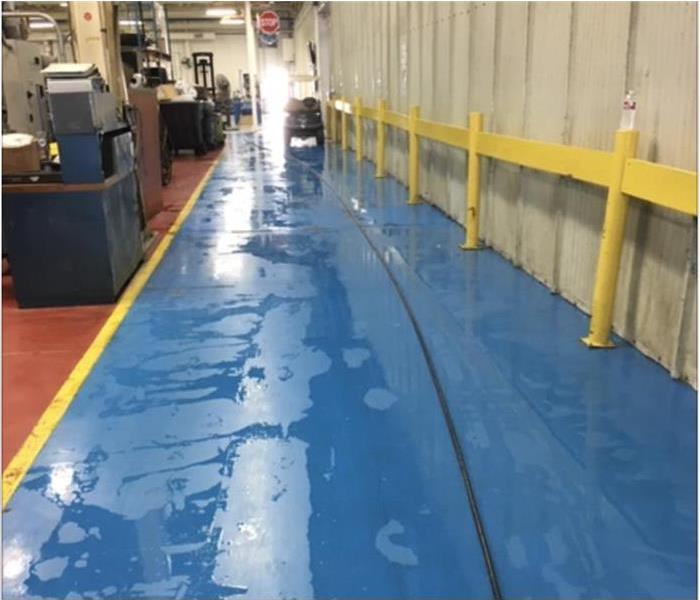 Water damage in a commercial building in Ceres, OK
Water damage in a commercial building in Ceres, OK
3 Questions To Understand About Commercial Content Cleaning
The last thing a business owner wants to deal with is a flooded company. This situation, after all, is both physically and emotionally messy. The establishment in Ceres, OK, must not only be closed, but it must also receive a thorough cleanup, preventing any complications with staff or clients. As proprietors sift through their valuables, they'll need to consider if they can keep something or toss it.
1. How Do You Know What Can Be Saved?
Work with a water restoration company to inspect and review your assets. The experts can look over everything, providing suggestions for what should be done. They'll consider the following points:
- What type of water contacted the piece?
- Is the item porous or nonporous?
- How easily could the owner replace the belonging?
The answers here are vital. As they survey the contamination, the team can provide a plan for you, offering dry cleaning to immersion services. In fact, with their high tech equipment, they can sanitize even electronics and documentation. Don't think all of your hard work has to go to the curb. Discuss the various options available.
2. What Precautions Should Be Used?
A flooded company is a hazard, particularly if the overflow came from a sewer line or external source, such as a lake or ocean. The microbes are seeking residence, growing within the walls and floors. For this reason, extreme caution should be taken to wash anything from the impacted zones. Appropriate personal protective equipment such as masks, gloves and eye wear should be used, preventing germs from spreading.
3. Is Clean Water An Issue?
Even a broken pipe that sprays freshwater is complicated. While it may not contain the microorganisms, too much of it could lead to mold. The major factor would be who easily the scrubbing process could be done. A nonporous substance took in very little, leaving it a simple procedure. Porous pieces, however, are far more complicated. They may not make it.
A flooded company doesn't mean a complete loss. Speak with professionals for guidance.
3 Tips to Prevent Toilet Plumbing Issues for Your Business
4/27/2020 (Permalink)
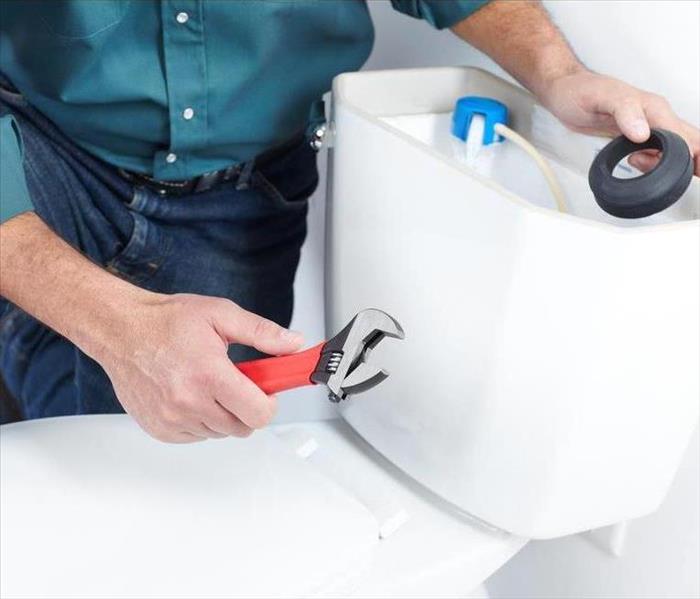 A clogged toilet can become a serious problem for a business.
A clogged toilet can become a serious problem for a business.
Dealing with a clogged toilet is one of the most common plumbing problems experienced by businesses in Stillwater, OK. Overflow is another. There are some preventative maintenance measures your business can take to minimize these types of little disasters. Here are some tips to help businesses alleviate their toilet woes.
1. Tree Roots Growing Through Your Line
While trees in Stillwater, OK, offer many benefits, the trees growing directly around your facility have roots that are also growing under it. These roots damage countless numbers of sewer lines every year. The issue can suddenly sneak up on you, and before you know it, toilets are backing up, and if the backup happens while you are away, it can cause massive damage to your flooring and structure requiring the services of a clean up and restoration company.
The best way to prevent root growth is to kill the roots. There are many root killers on the market, and by applying the root killer as often as recommended by the manufacturer, which could be as often as monthly, this problem will be less likely to happen in the future.
2. Keep Up with Slow Drains
If you notice toilets draining slower than usual, it's time to plunge. Be sure to use a plunger that is designed for use with toilets. If plunging fails to correct the plumbing issue, there could be an item stuck in the s-trap and you should call a plumber before the problem worsens into an overflowing or clogged toilet.
3. Hard Water Deposits
Hard water deposits are common and can be seen building up under the rim of your toilets. These should be removed and a preventative solution made of one part muriatic acid and ten parts water should be poured down the tank's overflow tube. Removing these deposits will improve the flush ability of your toilet.
A clogged toilet can become a serious problem for a business. Regular toilet maintenance will ensure these burdensome plumbing issues are less likely.
What To Do About a Wet Crawlspace
2/11/2020 (Permalink)
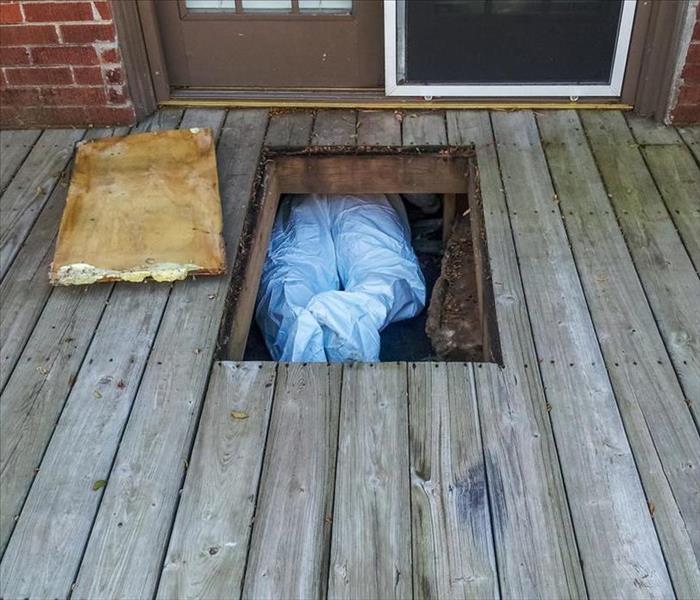 A wet crawl space under your Navina, OK, home can cause problems in the rest of your house
A wet crawl space under your Navina, OK, home can cause problems in the rest of your house
Common Causes of Crawl Space Floods
A wet crawl space under your Navina, OK, home can cause problems in the rest of your house. Fortunately, it is possible to dry out a crawl space and prevent future flooding.
Preventing a Crawl Space Flood
Because many crawl spaces are not waterproof, they can take on moisture for many different reasons. The following are some common causes of crawl space floods:
- Clogged gutters
- Insufficient grading away from foundation
- Leaks from indoor or outdoor pipes
Make sure that your landscaping and gutter system allows water to flow away from the foundation. Your lawn should slope away from the crawl space, gutters should be well-maintained and downspouts should be directed away from the house. Additionally, repair any leaks as quickly as possible, and notify the municipal authorities if a public pipe bursts. If your crawl space floods frequently, you may consider installing a sump pump or having the area encapsulated to prevent future floods.
Drying Out a Crawl Space
If you find yourself with a wet crawl space, it is important to address the problem as quickly as possible to prevent mold growth and structural damage. First, make sure that water is no longer flowing into the area. Repair the leak, wait for the storm to pass, etc. Then, remove the soaked materials. This makes it easier to determine if they can be salvaged and speeds up the drying the process. After that, begin drying out the crawl space. Most likely, you will need a pump to accomplish this. You can also use dehumidifiers and commercial-grade fans. After the crawlspace is dry, clean mold growth off of the piers, joists and other surfaces. When everything is clean and dry, you can begin repairing or replacing all affected materials.
If your home suffers a wet crawl space, it is important to address the problem quickly to prevent mold growth and structural damage. If the damage is serious, or if you suspect your crawl space contains asbestos or other harmful materials, you may decide to enlist an experienced restoration team to help you get your home back to normal quickly and safely.
How To Prevent Clogged Drains in Your Rental Property
1/28/2020 (Permalink)
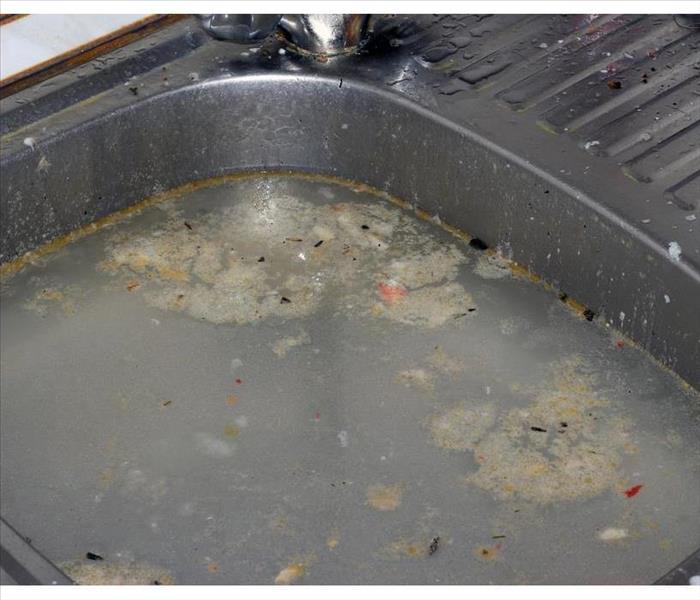 Clogged drains can severely damage the polybutylene pipes in your rental property
Clogged drains can severely damage the polybutylene pipes in your rental property
If you own an old rental property in Ceres, OK, you need to be careful about keeping everything in top condition. Older parts need regular care and maintenance to consistently stay in working order. One of the most crucial risks to avoid is water damage, which can result from clogged drains, flooding or other problems. Be sure to take the following steps to keep your polybutylene pipes clear and running smoothly.
Add a Drain Grate or Screen
To ensure that no harmful materials enter your pipes, add a grate or screen over your sink’s drain topper. By using a drain screen or grate, you can prevent the following objects from entering your drain:
- Hair
- Dirt
- Food particles
- Cosmetic products
- Paper
While a drain grate can be a highly effective addition to your sink, it’s important to note that it may not block out all harmful substances. For example, viscous liquids such as grease and oil might still pass through the drain and cause severe harm to your polybutylene pipes. It’s, therefore, your renters' responsibility to limit the substances that enter their drains to prevent clogs from occurring.
Monitor Garbage Disposal Use
If the sinks in your rental property include a garbage disposal feature, make sure it's being used correctly. Always encourage your renters to run cold water over the drain while using the disposal, as this can help food particles slide through the pipes more smoothly. Failing to run the water while using a garbage disposal may cause damage to the pipes.
Regulate Flushing
Many toilet clogs occur when renters flush objects that aren’t meant to be flushed. To keep your toilet drains clear, be sure to hang up signs that prohibit renters from flushing harmful objects. Feminine hygiene products, dental floss, tissues, and other common household objects should be thrown directly into the trash.
Clogged drains can severely damage the polybutylene pipes in your rental property. If you notice any signs of water damage, don’t hesitate to call commercial building restoration services as soon as possible.
FAQs About Basement Floods
12/6/2019 (Permalink)
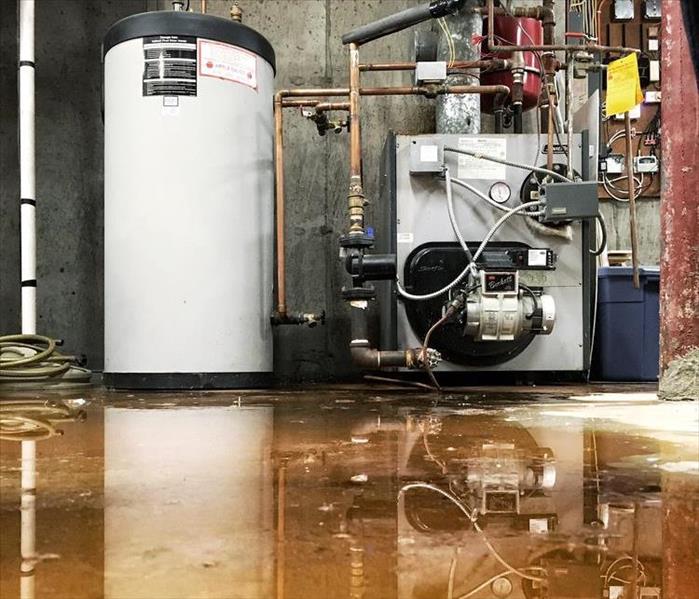 Broken water heater causes flood on basement in Perry, OK
Broken water heater causes flood on basement in Perry, OK
Learn About Flooded Basements
Basements are often great additions to homes, regardless of whether you use your basement in your home in Perry, OK, for storage or for spending time with family. Unfortunately, flooding is a common issue that frequently affects basements. If you have a basement in your home, it can be useful to learn about flooded basements.
What Causes a Basement Flood?
There are various reasons a basement may become flooded. However, some of the most common causes of flooded basements include:
- Natural disasters that cause heavy rains
- A broken water heater
- Damaged supply lines
- Pipe bursts
How Is Water Removed From a Flooded Basement?
Sump pumps and water vacuums are often useful to mitigate small to moderate amounts of water. However, if flooding has caused large amounts of water to enter your basement, you may want to consider contacting water damage restoration professionals. Experts have access to powerful tools and equipment that can remove large amounts of water, and professionals also know how to remain safe when removing contaminated water.
Can You Prevent a Flood in Your Basement?
Since there are various reasons a basement may flood, there is no guarantee that you can prevent your basement from all floods. However, it is possible that you may be able to prevent floods not caused by natural disasters. Ensuring that all appliances and pipes are working effectively and requesting an inspection if you need an appliance or pipe repair can help to prevent a flood. It's also often useful to look for signs of water damage so as to prevent a small problem from turning into a big disaster.
Your basement is an important part of your home, and an area that is particularly prone to water damage from a flood. It's often helpful to know the causes of flooding in basements, how water is removed from a flooded basement and how to prevent a basement flood.
4 Things To Do Before Your Adjuster Arrives
10/18/2019 (Permalink)
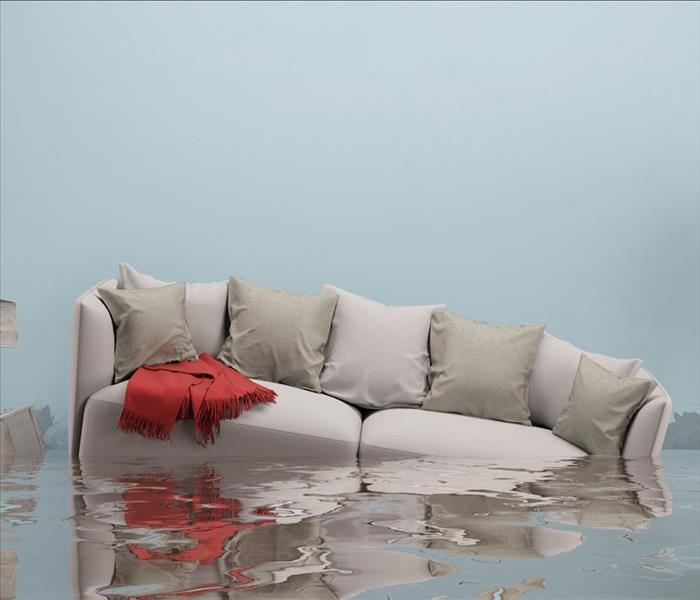 Water damage in a Guthrie, OK home
Water damage in a Guthrie, OK home
4 Things To Do Before Your Adjuster Arrives
When your home floods after a storm in Guthrie, OK, your first call is probably to your insurance company. The company will send a home adjuster to evaluate your claim. Here are four things you can do to make this visit go more smoothly.
1. Call Repair Specialists
Water damage in your home requires professional remediation. By scheduling an assessment of the problem with water restoration experts before your adjuster arrives, you can gather information that substantiates your insurance claim:
- Parts of the structure that need to be repaired or replaced
- Extent of the damage
- Estimated cost of the restoration
2. Document Damage
You don't want to delay the remediation process, but you still need proof of the original damage. Pictures or video taken of your home right after the flood can help your home adjuster in his or her assessment. Keep every damaged item you can so that you have physical proof as well.
3. List Replacement Costs
Every item that is ruined by flooding may need to be replaced. Start a list of these items and jot down their replacement cost. If you have receipts of major purchases to back up your list, that's even better. Gather all your documents in one place so that you are ready to present them to the adjuster upon arrival.
4. Keep a Copy for Your Records
Your adjuster isn't the only person who needs a record of your losses. Make copies of everything before you hand the documents and lists over. The remediation company will likely keep electronic records that are shareable with the insurance company. Make sure you know how to access them as well.
Dealing with a home flood may seem like a huge task, but mitigation professionals and your insurance company are there to assist you. If you complete this checklist before your home adjuster arrives, you can help the process get started smoothly.
How To Prevent Water Damage at Home When You’re Away on Vacation
6/12/2019 (Permalink)
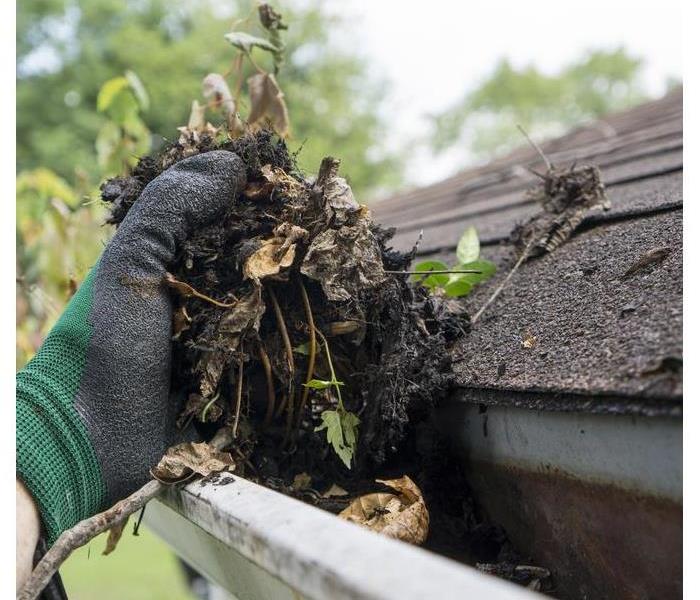 Cleaning out leaves from your gutters allows rain to flow freely and can decrease the chance of water damage
Cleaning out leaves from your gutters allows rain to flow freely and can decrease the chance of water damage
How to Prevent Water Damage in Your Home, While You're on Vacation
Going on vacation should be an enjoyable experience, but worrying about a water pipe repair or a leaking appliance in your home can make it difficult to relax. However, there are steps you can take to prevent water damage in your home in Sumner, OK, while you’re on vacation.
1. Prepare Before You Leave
There are several steps you can take before leaving to decrease the likelihood of coming back to a flooded home. Cleaning out leaves and twigs from your gutters allows rain to flow freely and can decrease the chance of water damage. Additionally, you can spot a minor issue and react appropriately if you examine the appliances in your home that use water prior to leaving.
2. Ask a Friend To Monitor Your Home
Even if you prepare your home, water damage often occurs without warning, and the longer it goes unnoticed, the more damage that your home will likely sustain. However, a friend monitoring your home can quickly alert you if your home needs a water pipe repair or if an appliance is leaking. Once you are alerted, you can contact emergency restoration services who can help to ensure that the issue is resolved quickly.
3. Turn Off the Water If Necessary
If you can’t find a friend to check up on your house while you’re away, it can be helpful to turn off the water in your home. If you are going on vacating and know the temperature outside may dip below freezing, it can be useful to keep the heat running and to open the cabinet doors to minimize the risk of a broken pipe. By turning off the water, you can greatly reduce the chance of your home sustaining water damage.
The last thing you want to think about while on vacation is a water pipe repair or a flood in your home. Preparing your home before you leave, having a friend monitor your home and turning off the water if needed can help to keep your home free of water damage while you’re away.
The Importance of Choosing the Right Commercial Water Damage Restoration Company
4/19/2019 (Permalink)
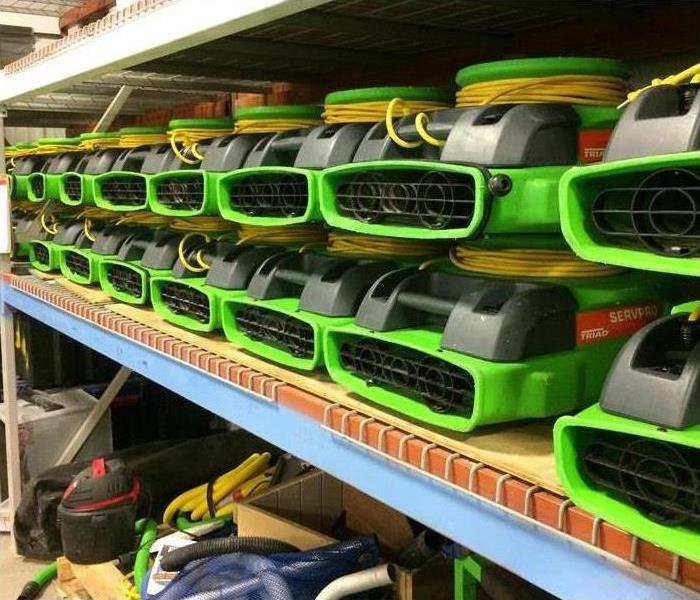 Having the right help to assist with a pipe burst cleanup can benefit a business.
Having the right help to assist with a pipe burst cleanup can benefit a business.
Water damage affects many businesses in Stillwater, OK and picking out a company to help with restoration can be overwhelming. However, there are various ways an efficient commercial water damage restoration business can make the process of a pipe burst cleanup easier.
1. Save Affected Items
Often, there are a multitude of items that are impacted after flooding occurs in a business. Everything from building materials to electronics can sustain damage. Although some restoration companies may only specialize in removing the water present in the building, it can be helpful to employ a restoration business that has the ability to restore various items.
2. Decrease the Cost of Claims and Save Time
When water damage experts are able to restore items instead of replacing them, the cost of your insurance claim is likely to decrease since restoration is generally less costly than replacement. Additionally, commercial water damage restoration experts are likely to know what practices and methods are most effective when it comes to pipe burst cleanup and mitigating the effects of flooding. By using the most current practices, professionals will be more likely to complete the restoration process in a timely manner.
3. Avoid Secondary Damage
Unfortunately, secondary damage such as mold growth is a common occurrence after a flood is caused by a broken pipe or a broken appliance. However, the right restoration company can help to prevent issues such as mold growth if water is quickly removed and the area is kept dry. Additionally, a sewer cleanup company can help to remove black water, water contaminated with hazardous materials, safely and quickly, which can help to prevent additional issues from occurring.
Having the right help to assist with a pipe burst cleanup can benefit a business. An experienced commercial water damage restoration company can help to save damaged items, decrease the overall cost of claims and save time and help to avoid secondary damage.
What Is Black Water?
2/25/2019 (Permalink)
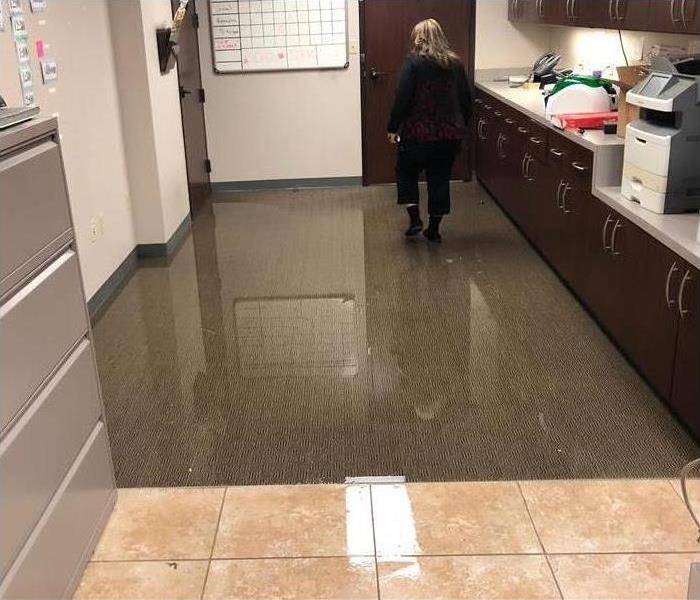 Commercial water damage restoration in Stillwater, OK
Commercial water damage restoration in Stillwater, OK
What Is Black Water?
Commercial building owners in Stillwater, OK who have recently experienced a flood might have water remaining on the premises that’s black in color and looks anything but safe to drink. This type of water is known as black water, and not only can it lead to water damage if left unattended, it’s also often highly contaminated. Learn a couple of facts about this brackish water and the many dangers it poses to you, your building and your employees or residents.
1. The Hard Truth
Rather than beat around the bush when it comes to sharing the truth about contaminated water, it’s best to be straightforward. Water from flooding is essentially wastewater, which means it carries a high number of harmful pathogens, bacteria and the like. Gray water is a specific type of water that comes from sources other than the toilet, such as washing clothes, dishes, bathing and showering. No matter whether you have gray or black water, you can likely smell it and need to take care of it as quickly and efficiently as possible to prevent further water damage.
2. Addressing Water Leftover From Flooding
Thankfully, you don’t have to put yourself or anyone else at unnecessary risk when it comes to dealing with contaminated flood water. Professional services are available that know how to mitigate further damage to your building and better ensure that neither you nor your employees or building residents are in any needless harm. There are still a few steps you’ll want to take on your own before professionals arrive to keep damage to a minimum.
One of the first things to do is to limit your contact with flood water and water that even looks as though it might be contaminated. It’s also best that you wash your hands before eating or drinking anything, even if you didn’t come in direct contact with flood water. If there are children around, see to it that they do not play in brackish water. Anyone who has cuts, scratches or open wounds should take extra care when around potentially contaminated water.
Black water from a flood isn’t something to mess around with. Take preventative action to prevent water damage and risks to your health. Visit http://www.SERVPROstillwaterguthrie.comfor more information on water damage.
Plumbers Are for the Weak! You Can Replace Your Own Toilet With These 5 Simple Steps
1/17/2019 (Permalink)
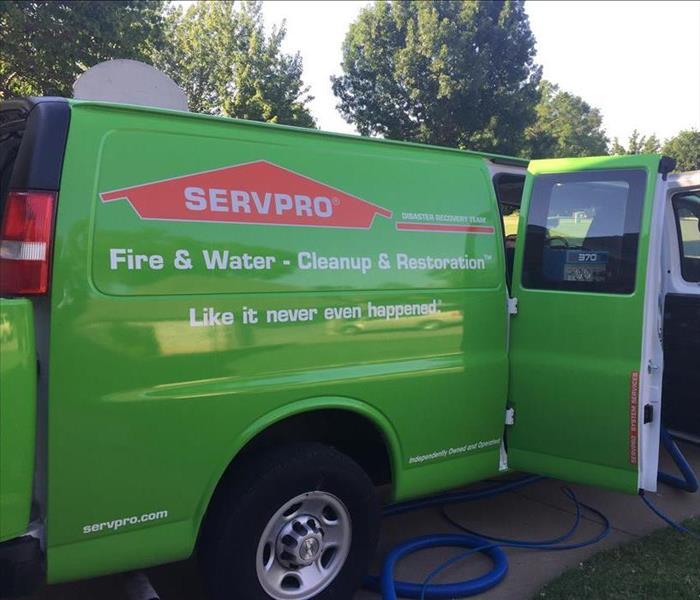 Call in a Guthrie, OK water damage restoration team to ensure there is no extensive water damage
Call in a Guthrie, OK water damage restoration team to ensure there is no extensive water damage
Replace Your Toilet with 5 Simple Steps
Whether you're dealing with a leaking toilet or you simply found a toilet with crazy features at your local hardware store that you just could not live without, you may wonder how much it will cost you to have a Guthrie, OK, plumber come in to make the swap for you. Depending on your capabilities, resourcefulness and level of confidence this may be an unnecessary concern. You can replace your toilet five simple steps.
1. Sever the Water Supply
Whether you're making a toilet repair or swapping out an old toilet with a new, you need to be sure to cut the water supply. Once the supply line is disconnected, flush and drain the tank.
2. Detach the Wax Seal
Use a wrench to loosen the bolts holding the toilet, then take a pocket knife or other sharp object and cut the caulk seal surrounding the base of the toilet. Remove the toilet gently. Use a putty knife to remove the wax seal.
3. Caulk the New Base
This step can help you prevent a future leaking toilet, as caulk serves to eliminate gaps between the wax ring and toilet base. It also helps make installation easier.
4. Install a New Wax Ring
You do not want to reuse a wax ring. Place a new one where the old was, and then lift the new toilet into place. Do not press down, as the weight of the fixture will compress the seal itself.
5. Tighten the Bolts
Once the toilet is in place, place a washer over the bolts and tighten the nuts by hand. You can use a large screwdriver or wrench to finish the job. Be careful to not overtighten, as it will crack the ceramic.
If your leaking toilet was leaking for a while, you may want to call in a Guthrie, OK, water damage restoration team to ensure the there is no extensive water damage. Failure to properly clean water damage can result in costly issues in the future.
4 Steps to Prepare For an Adjuster’s Visit
12/30/2018 (Permalink)
 Removing insulation after a water loss in Perry, OK
Removing insulation after a water loss in Perry, OK
4 Steps to Prepare For an Adjuster’s Visit
The process of filing an insurance claim should proceed smoothly if a policyholder prepares for a visit from an insurance adjuster. A home adjuster will need information about building materials, contents, and structural damage. Here are four steps to help homeowners prepare for an adjuster's visit.
1. Gather Information
Assemble as much information as possible about contents and building materials that have sustained damage. It can be helpful to obtain an expert opinion regarding which items or materials can be cleaned or repaired and which will need to be replaced. Helpful information includes descriptions of items, approximate dates of purchase, and the estimated cost of repair or replacement.
2. Find Signs of Damage
A home adjuster will probably also want to see signs of damage. A policyholder should make a list of damage to show an adjuster. Homeowners may also want to take photographs or record video footage to submit to the insurer or keep for their records.
3. Obtain Bids
Homeowners may be able to expedite the process of filing a claim by obtaining estimates from contractors and specialists that perform mitigation and restoration. The more itemized these bids are, the more likely it is that the claim will be approved and processed in a timely manner.
4. Make Copies
Make at least one extra copy of any documentation submitted to an insurer. Keep copies of all the paperwork the insurer provides. Policyholders should also keep a record of the names and phone numbers of adjusters you talk to in the process of filing proof of loss.
These measures will help homeowners prepare for a visit by a home adjuster, and should increase the likelihood that an insurance claim will be processed in a timely manner. If you require the services of a residential damage mitigation and restoration company, look for a company trusted by insurers in Perry, OK.
3 Ways Leaks Can Affect Your Home
10/9/2018 (Permalink)
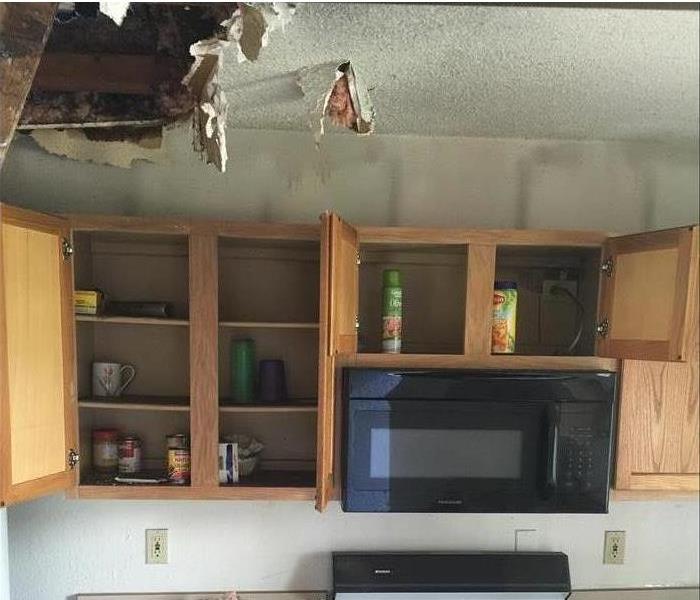 Ceiling damage due to leaking pipe in a Perry, OK kitchen
Ceiling damage due to leaking pipe in a Perry, OK kitchen
The sound of water dripping in your home in Perry, OK, isn’t just annoying, but it’s also dangerous. It may be the first sign of a bad leak, which means you might be facing water damage. With the help of restoration professionals, you can fix these problems without concern or worry. However, it’s important to stay mindful of the possible challenges you may face such as water in light fixtures and damaged valuables. Here are three potential problems you should be aware of.
1. Structural Harm
Sometimes leaks aren’t noticeable until they affect the areas around them. Water can cause drywall to swell and warp, which can lead to structural problems. Things such as support beam collapse and ceiling damage can occur.
Look around for any bulges or weird stains. This can help you find problems and stop them before they become more complicated.
2. Damaged Valuables
Leaks can affect places that should remain dry, including areas that hold your valuable objects and furniture. Bookshelves, memory boxes, and antiques can easily get ruined if a leak is not taken care of.
It doesn’t hurt to check your valuables often for any damage. If you find water damage, find the source of it and get it fixed quickly to avoid future issues.
3. Dangerous Light Fixtures
Sometimes, a leak might happen near electrical fixtures. If you see any water in light fixtures, stay away. Water conducts electricity and can electrocute you when you come into contact.
If you see this problem, shut off the electricity immediately. Once you have successfully turned off the power and eliminated the possibility of getting electrocuted, you can contact professionals and address the problem.
Leaks can be troublesome and sometimes dangerous if you aren’t careful. It’s best to prevent them before they occur. If you are currently dealing with a problem such as water in light fixtures, seek professional help and get started on the restoration and repair process.
Understanding Crawl Space Water and Its Removal
6/22/2018 (Permalink)
A crawl space in your Stillwater, OK, home is no place for water to linger. Whether it’s mold that thrives in cold and damp places or foundation weakening from overexposure, water poses a threat in the long term. Knowing how a wet crawl space becomes flooded and what do after is pivotal.
Knowing Where the Water Came From
Water finds its way into the crawl spaces naturally and otherwise. The crawl space is susceptible to water from a few sources:
• Rain or snowmelt causing water pools that never fully evaporates
• Flood water from naturally wet climates
• Other floods above the crawl space entrance leaking through
• Leaking or broken pipes spilling water when water is used
Removing the Water
If the problem is a damaged pipe, the pipe should be fixed first. If the problem is more long-term or serious, a draining system is set up to remove and prevent the flooding from creating a wet crawl space. A trench is dug while keeping the home’s structural integrity in mind. In the trench, piping is placed and covered with drainage rocks.
After the trench and piping are complete, an electrician ensures the safe installation of an outlet and sump pump. The water is rerouted to a safe spot in the home’s exterior where it is much less dangerous. As the final step, a vapor barrier is installed to prevent any water from evaporating and damaging the home any further.
Treating Water Damage
When a sump pump solution is not pursued, the water needs to be removed by you or professionals. Contacting a professional water damage treatment company is advised since expertise is necessary to evaluate every unique situation. Even with a removal system, water damage may still be there but unnoticeable unless you know what to look for.
The treatment and prevention of a wet crawl space is quite an endeavor, but it can be accomplished with established procedures. The source and treatment are important to know to protect your residence. For more information, visit http://www.SERVPROstillwaterguthrie.com/.
3 Reasons Your Toilet May Leak When Flushed
3/27/2018 (Permalink)
A leaking toilet in your Stillwater, OK home can be troublesome, especially if it leaks each time you flush. Over time, your bathroom floor can suffer water damage or mold may start to grow around the tank if the area is constantly wet. There may be several reasons for the leak; however, some may be surprisingly simple to fix on your own.
1. Failed Seal
If the base of your toilet is consistently damp or if new puddles form when you flush it, this is usually the result of a failed wax seal at the bottom of the unit. This can be a common cause of leaks in older toilets, but you may be able to fix it by using a wrench to tighten the bolts at the base of your bowl. If the toilet leaks again when you perform a test flush, the wax gasket may need to be replaced.
2. Broken Flange
A bathroom leak can be caused by a broken flange underneath your toilet. This repair can be challenging, as you will have to remove the entire toilet to change the flange, but careful preparation can simplify it. The flange is located underneath the wax ring, which you will have to remove as well. A new flange and ring can be purchased at your local plumbing or home hardware outlet.
3. Loose Unit
Sometimes the fix for a leaking toilet can be quite simple. For example, if the bolts that hold the toilet to the floor have loosened over the years, it may leak when flushed. To repair this issue, loosen the bolts the rest of the way, press down on the unit to make a tighter seal with the wax gasket, then bolt the unit down securely. You may want to call in a flood cleanup and mold remediation company to have your bathroom checked and treated for mold.
A leaking toilet in your Stillwater, OK home is cause for concern. However, the problem may not be as severe as you think, and knowing why these leaks are happening can help you repair them as quickly as possible. Visit http://www.SERVPROstillwaterguthrie.com for more information on water damage.
Estimating Damage From Flooding
2/19/2018 (Permalink)
The home restoration and storm restoration company will want to take a tour of your home.
This is so that they can get an accurate feel for the extent of the storm damage. They will check for roof leaks and electrical problems. They will then create a plan and a strategy for the process of storm remediation.
Removing the Water
When removing the flood water from your home or the ground water from your basement, the water restoration and storm damage company will use special flood pumps. These flood pumps can go under the ground water and suck out all the flooding. Besides using flood pumps, the water restoration company will use equipment to help suck out the moisture that may remain after most of the flooding is removed from your home or basement. Like flood pumps, these tools help remove moisture that is hidden behind walls, under tiles, or inside soaked furniture.
All of the services of SERVPRO of Stillwater / Guthrie will be estimated and sent to the insurance adjuster working with your insurance company.
Has Your Roof Been Damaged by Storm?
2/19/2018 (Permalink)
A roof damage and storm restoration company will deal with roof leaks on your roof.
Whether they are caused wind damage or hail damage, they will do roof repair as soon as possible. Roof repair is an important part of the process of storm remediation.
In fact, taking care of the roof is necessary to keep your home dry. If it is still leaky, more flood water may enter your home and cause damage. In addition, the longer roof leaks are left unattended, the larger they become, and the greater the risk for flooding.
If the home cannot have the roof fixed right away a tarp may be used to mitigate damage. SERVPRO of Stillwater Guthrie has the necessary equipment to keep your roof from leaking water.
For more information visit www.SERVPROstillwaterguthrie.com.
Water Loss Renovation of a Home
2/19/2018 (Permalink)
Home renovation is the final step in the process of storm remediation.
Home renovation will make sure that your home is not just safe to live in, but that it is fully restored to preloss conditions. That is why it is called home restoration. The company will first repair any structural damage. This means that some parts of your walls, ceiling, and floors may need to be removed. Some beams may need to be replaced. Some may simply need to be reinforced and strengthened. It all depends on the extent of the damage and the ferocity of the storm. The company will paint your home again so that it looks great. They may also do additional renovation jobs once they are at it.
SERVPRO of Stillwater / Guthrie has more services. Visit www. SERVPROstillwaterguthrie.com for more information.
What You Need To Know About Contaminated Water
1/10/2018 (Permalink)
After a flood, there’s a lot to do, and there’s a lot to know. Before you can even touch on the cleanup process, it’s important to understand the classifications of flood water. The process that you or your restoration specialist will have to undergo may vary between the three classifications.
Category 1
Category 1 water is considered clean water, which is not a threat to you or your family. It does not carry any harmful bacteria or pathogens. For instance, this water can include:
• Broken water lines
• Toilet holding tanks
• Melted snow
• Rain water
Because category 1 is not contaminated water, it can be cleaned easily. Also, if clean water dries out quickly, it should leave little to no damage.
Category 2
Category 2 is called gray water, which may have some chemical contamination. For instance, dishwashers and washing machines may leak soapy water and biological matter. Most gray water comes from these appliances, but also sinks and aquariums.
Category 3
The final category is black water, or severely contaminated water. Gray water can become black after 48 hours. Unlike clean water that may come from the supply line, category 3 water carries bacteria and pathogens. Often sewage or outside water falls within this category. While you should always act in haste after a flood, you have to be particularly fast and careful with this type of polluted water.
Flood cleanup can be a difficult time for anyone. However, in order to make the most out of your cleanup and to stay safe while working, you should keep in mind the classifications of flood waters. Category 1 is relatively harmless, while category 3 contaminated water not only can be dangerous to your health, but can cause serious damage to your Stillwater, OK home. However, after any flood, it’s imperative to work on cleanup efforts as soon as possible. Visit http://www.SERVPROstillwaterguthrie.com for more information on water damage.
What to do if I have frozen pipes this winter and they break?
12/16/2017 (Permalink)
If you have water damage from frozen pipes, Contact SERVPRO immediately. They will have a trained and experienced team member on site quickly to evaluate the damages.
In any water damage situation, timing is very important. The longer the water sits in your home or business, the more likely secondary damages can occur. SERVPRO makes sure to follow all of the guidelines of the IICRC.
It is critical to make sure plenty of pictures are taken on any water loss. This way if there are any problems, the job will be well documented. On any job, SERVPRO's main goal is to get the job done quickly and efficiently.
If you have any questions about water damage restoration, contact us directly at anytime. We have team members standing by, 24/7, 365 days a year.



 24/7 Emergency Service
24/7 Emergency Service































